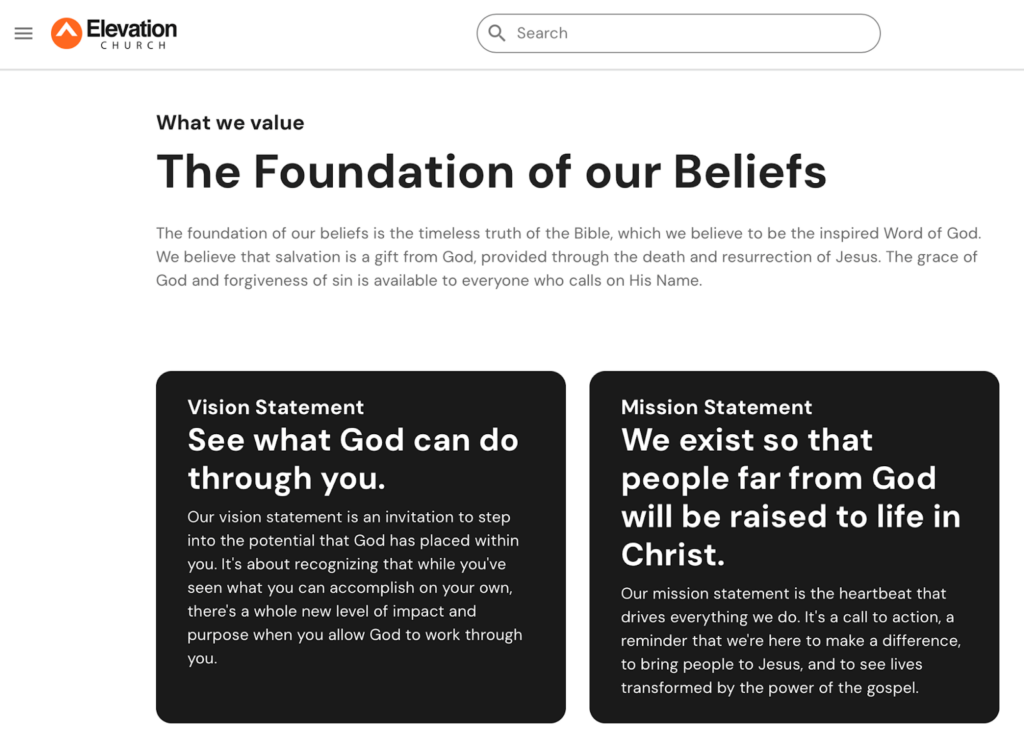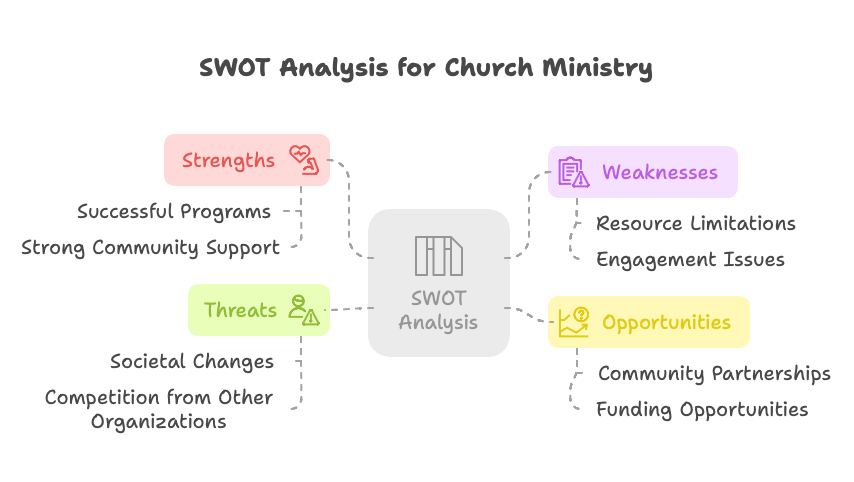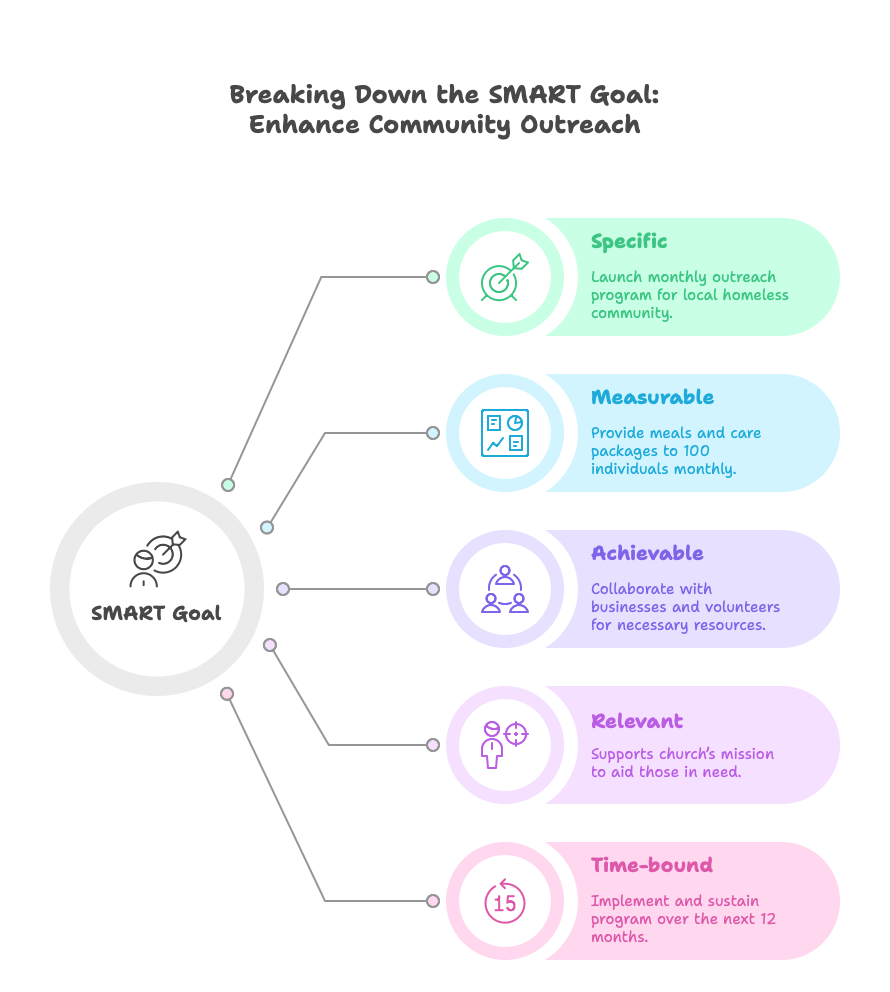Embrace church strategic planning as ministry: This mindset shift is foundational. Without it, everything else feels like busywork.
Anchor your plan in vision: Vision gives direction and purpose. Without it, planning becomes disjointed and reactive.
Build accountability into the process: Execution is everything. A great plan without follow-through is wasted energy.
You need a church strategic plan. Will there be pushback along the way? Yah, it's nearly guaranteed:
- Well, it’s just the way we have always done it.”
- “If it’s working, why would we change it?”
- "Change for the sake of change is pointless."
- "I don’t see the need to reinvent the wheel."
But the truth is, change is necessary and good. But we don’t want change just for the sake of change. It needs to be purposeful.
Strategic planning is not just for businesses—churches need it to stay intentional and effective. A good plan aligns church efforts with God’s mission, prevents aimless activity, and ensures leadership is equipping the saints for ministry rather than just doing it all alone.
I’ve got the tools and resources you need to create a stellar strategic plan. While you’re here, take a look around and find out the best church management software tools.
What Is Church Strategic Planning?
Strategic planning is a prayerful step-by-step action plan to accomplish long-term goals for your church.
According to Brandon Kelley (PreachAndLead.com), a strategic plan:
- Is the tactical execution of a church’s vision.
- Ensures churches intentionally progress rather than just staying busy.
- Aligns resources, gifts, and leadership toward long-term goals.
- Encourages a five-year vision, working backward to define actionable steps.
A good strategic plan will drive the mission and vision of your church. While it can feel intimidating, take it as an opportunity to dream alongside those who share a love for Jesus and the church you are part of. These worthwhile conversations can set the trajectory for your church long-term.
Strategic planning is a crucial part of the pastoral role, but according to Barna GroupCatron, “very few pastors (just 31 percent) consider strategic thinking among one of their top giftings.”
It starts by assessing your current situation.
What are your strengths and weaknesses? Are there any current struggles or opportunities your church is facing? Build your church plan and execute it based on what matters. Then, be sure to evaluate and reassess your plan as needed to stay on track with your mission and goals.
Why Is A Strategic Plan So Important for My Church Leadership?
Without a strategic plan, you may find you are experiencing activity without progress – lots of programs but little disciple-making. Or maybe you feel like you are simply in survival mode, just trying to make it from one Sunday to the next. When this is happening, there is no time for long-term planning.
Taking the time to reflect and develop a strategic plan with your team is a powerful, inspirational experience. It’s crucial for engaging new leaders, improving your work, raising more funds, and deepening your relationships with community partners.
The strategic planning process brings clarity and definition to the heart of your church, which in turn can bring unity and increased drive to fulfill your mission. I know, strategic planning sounds like a business term, and I guess it is. The reality today is that in the course of our work as pastors, business management is an important part of the job.
A strategic plan will help you:
- Align the church’s mission with God’s calling, ensuring all ministries work toward a common goal.
- Enable wise use of resources (time, finances, and people) by prioritizing efforts that have the greatest impact for the ministry.
- Foster the long-term health of the church, which in turn can lead to sustainable growth within your congregation.

Your Church Strategic Plan Should Include…
No two strategic plans are the same. Your strategic plan will be as unique as your church and the people that make up its members (and I know just how unique some of those members can be 😉). That being said, it wouldn’t be a strategic plan without these core attributes.
Part 1. Church Vision Statement
Clearly define your church’s long-term direction.
Your vision will answer the question of where you want to see the church in the long term. It should be clear, memorable, and to the point. If you are struggling with drafting your vision, just remember to keep it simple. Maybe the Great Commission is a great place to start.

Part 2. Church Mission Statement
Your mission statement will define your core purpose and how you plan to accomplish your purpose. The vision statement will describe where you are going, whereas the mission statement is the what and why of the church.
A clear church mission statement will unite 100 competing ideas of what the church is about into a single idea.
Here are some questions to ask as you draft your mission statement:
- Why does our church exist?
- Who are we trying to reach?
- How will we reach them?
- Does our mission resonate with our people, and how can we make it memorable?

Part 3. A SWOT Analysis
Before you begin your plan, you need to start by understanding the current state of your church. To reach your destination, you must have a starting point. A SWOT Analysis provides a framework for understanding your starting point. As a planning team, start unpacking these four areas at your church.
- Strengths - Look for aspects of the ministry that are going well. Consider how you can maintain and expand in these areas.
- Weaknesses - The trouble spots in your church might need some extra care and attention as you move forward in your plan.
- Opportunities - Consider any opportunities that the church can take advantage of to accomplish the mission and vision (eg, new technology or fundraising techniques).
- Threats - Are there any external threats to the church that you can be proactive about now? While you can’t foresee every possible problem, being aware of these may prevent problems in the long run.

Part 4. SMART Goals
Break down goals into practical steps with deadlines and accountability.
You are more likely to reach your goals if you break them down into actionable steps to get there. It gives your team a sense of direction and purpose. Make sure your goals are SMART:
- Specific - Be precise with your goals. Don’t just say you want to increase small group participation. Outline the action steps to make it happen. This might be the time to utilize church software to help you attain your goals.
- Measurable - Make your goal measurable so you will know if you have reached it.
- Attainable - Be realistic in your goal. It’s no fun if you can never reach your destination.
- Relevant - Keep your mission and vision in mind as you set your goals and make sure they align.
- Time-Based - Set a specific time frame for achieving your goals. This will give you and your team a target to reach for.

Part 5. Budget and Financial Plan:
Develop a budget, fundraising plan, and stewardship strategy.
Don’t be afraid to work strategic planning into your budget. The Unstuck Group recommends that 2-3% of your annual budget be allocated to strategic planning. Putting a line item in your budget for strategic planning makes it easier to prioritize this important part of your church management:
With new goals and plans in place, draft a budget that will be effective in helping accomplish your plan. There may be changes and new opportunities coming up. With that in mind, you may need to consider additional fundraising to accomplish your goals.
Part 6. Communication & Marketing Strategy
Plan how to effectively share the church’s vision and events.
Now that you have your strategic plan, don’t file it away in a locked cabinet. Get the word out and communicate it to your leaders and congregation. Let them catch the vision and get excited about your church’s future. This will create momentum and increase the likelihood of success. (If communication is a sticking point for you, learn what NOT to say when someone is struggling.)
Clearly articulate your church’s mission, vision, and core values so that every communication aligns with them. Ensure messaging is consistent across all platforms (website, social media, emails, bulletins, etc.). Provide opportunities for feedback through surveys, suggestion boxes, and social media engagement.
Part 7. Evaluation and Adaptation of the Plan
Regularly review progress, assess effectiveness, and adjust strategies as needed.
Evaluating and adapting the plan is necessary for keeping your plan aligned with your vision and mission. Schedule reviews at regular intervals so you can assess the effectiveness of your plan. Follow-up with others to get a well-rounded understanding of how things are going.

Inevitably, you will face criticism, but that doesn’t have to be a bad thing. Learning to handle criticism can help you grow as a leader. Based on your evaluation, refine your approach by reallocating resources and modifying ministry structures.
Three GREAT Church Strategic Plan Examples
Sometimes, it helps to learn from what others are doing. Check out these examples from churches that have developed a strategic plan.
1: Connections Church Strategic Plan
Connections Church started in 2018 through the amalgamation of two churches. Their mission is to connect people with their calling. In 2020, the board of directors wanted to develop a strategic plan to guide the church’s mission and growth. Their goal with the plan was to:
- Align its activities with its mission effectively
- Reconsider staff structures
- Enhance community outreach
- Steward resources wisely
In their plan, they highlight how they want to equip their members and the specific values ot the church. Then they focus on the 5 key themes for their growth and implementation of their plan.
- Expand community service ministries by partnering with schools, nonprofits, and public organizations to meet local needs while sharing Christ through service, education, and leadership.
- Invest in the next generation so that the church community outlasts one pastor or leader.
- Develop the spiritual, physical, and financial gifts of its members.
- To be good stewards of the physical property and resources God has given them.
- To develop an organizational structure that supports the goals of the ministry. This can include implementing some great church management strategies.
Key: Create a supportive, organized structure with clear roles.
Your church will thrive when your staff is well-equipped, organized, and aligned in the mission of your church. A healthy staff loves Jesus, cares for one another, has a clear vision, and is accountable in their role.
Recommended REsource:
The Ultimate Guide to Church Staffing is an excellent article from the Unstuck Group (one of the best church consulting firms out there). It covers best practices when it comes to staffing. Check it out.
2: Kamloops Alliance Church Strategic Plan
Kamloops Alliance church was founded in 1944 and has been serving its community ever since. Their mission is to know Jesus and make Him known. Their vision is to see all people becoming fully devoted followers of Jesus Christ.
In their strategic plan, Kamloops Alliance Church identified the need for leadership development to fulfill its mission effectively. They established a strategic plan to become a "leadership development engine," aiming to train individuals for mission and ministry. Their goals include
- Spiritual formation
- Community
- Revival/Renewal
- Missional Engagement
- Leadership Development
Each area of development has 12-month, 36-month, and 60-month goals. Some highlights include launching an accredited theological training program and ensuring that every leader has an apprentice they are mentoring. By focusing on leadership development, Kamloops Alliance seeks to empower its congregation to make a meaningful impact in their community and beyond.
Key: Encourage community engagement among members.
Community engagement benefits churches by building relationships, fostering trust, and creating opportunities to serve. It helps meet local needs, strengthens the church’s impact, and transforms communities.
Through active involvement, churches can reach people with the love of Jesus. In the process, you will mature your congregation as the body of Christ and give them an outward focus (to not be church consumers). It promotes unity, collaboration, and a sense of purpose among church members.
Recommended Resource:
With community engagement comes events. Find the best church event management software to keep your events organized and running like a fine-oiled machine.
3: Sanctus Church Strategic Plan
Sanctus Church was planted in 1985 from Bethel Church in the Greater Toronto Area. From the humble beginnings of 40 people, they now have multiple campuses and thousands of people who call Sanctus their home church. They are no strangers to strategic planning, and their website shows a rich history of church growth and planning as they have grown and evolved over the last 40 years.
They developed a comprehensive five-year strategic plan focusing on four key areas: Presence, Reach, Develop, and Network. This plan aimed to establish a presence in local communities, reach out with the Gospel, develop individuals and leaders through discipleship, and build a network of trusted ministry partners.
KEY: Develop leaders who will disciple with Ggace
I’m a strong advocate for building communities of grace where authentic relationships can flourish. The best way to accomplish this is from the inside out. When your leadership team is living in freedom, it extends to the rest of the community. Create a culture of discipleship by developing leaders who can walk with and invest in the next generation of leaders.
Recommended Resource
TrueFace for Church Leaders is an organization that can help your church leaders to live and relate to others in true freedom and authenticity. I've got close personal experience with their team. They're a worthwhile investment!
Brandon Kelley: Four Keys to Developing a Successful Church Strategy
Your church’s strategic plan is too important to rush. Brandon Kelley, pastor and leadership coach from PreachAndLead.com, has worked extensively with churches, helping to develop strategic plans.

Key #1. Spend 6 Months Facing Facts
Before dreaming about the future, spend six months getting real about where your church stands today. Look at attendance trends, giving patterns, ministry effectiveness, and overall church health. Have the hard conversations. Dig into the numbers. Don't make decisions based on gut feelings—base them on facts. This groundwork ensures your church strategic plan isn’t built on wishful thinking but on reality.
Key #2. Identify What Really Matters
Once you know where you stand, focus on what’s most important. Which ministries are thriving? Where are resources being wasted? How can leadership better serve the congregation? Getting clarity on these key priorities keeps your church strategic plan from becoming a long list of nice ideas with no real direction.
Key #3. Build a Vision-Driven Plan
Now, craft a roadmap that connects today’s reality with tomorrow’s vision. A strong plan lays out a five-year direction, sets annual goals, and breaks them into quarterly action steps. Assign responsibilities, define key initiatives, and ensure everything lines up with your church’s mission. Without this structure, your plan is just words on paper.
Key #4. Follow Through with an Accountability Plan
Even the best plan is useless without action. Create accountability systems to keep your church healthy, track progress, and keep leadership and the congregation informed. A church strategic plan isn’t a one-time project—it’s an ongoing process that requires adjustments and long-term commitment. Execution is what turns vision into reality.
Join the TLP Newsletter: Stay Inspired and Informed
Want more practical guides to help your church grow with purpose? Subscribe to our newsletter to get the latest resources, best practices, and insights on managing churches from expert pastors and church leaders.
We'd love to have you!







